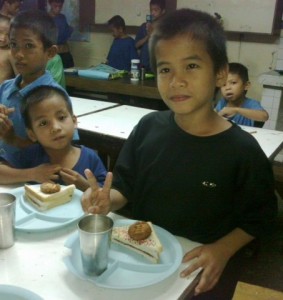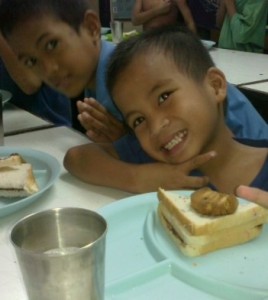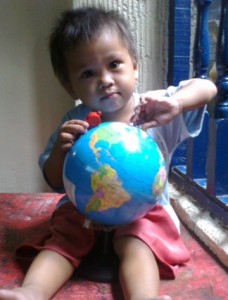“There are thousands of children living in the streets of Manila who have broken all bonds with their families. Victims of violence and of drugs, they survive by begging, by stealing, by prostitution… living totally in the margins of society.”
The Tulay Ng Kabataang (TNK) Foundation was set up in 1998 by Father Jean-Francois Thomas to provide a safe haven for more than 1000 children living on the streets, in the slums or on the dump sites of Manila. Funding comes from several European charities and covers the cost of feeding, housing, educating and rehabilitating these children in twenty two drop-in centres across the city. For the younger children, the foundation provides informal schooling designed to bridge the gap between life on the streets and formal schooling. For adolescents too old to start school, vocational training is provided.
 The ADBSA Social Welfare Committee visits one TNK drop-in centre in Quezon City every Monday to spend time with the boys. There are currently twenty five boys in the classroom, but numbers constantly fluctuate. The boys are aged approximately between 4 and 14, although many don’t know their real age. Many of the boys have been living on the streets, others have been taken from parents who are either drug abusers, child abusers, or simply too poor to keep them. One newcomer has been quarantined with scabies. Some will climb the walls to run back to the streets, and a few are retrieved by their families but hopefully some stay on to graduate and go on to ‘proper’ school.
The ADBSA Social Welfare Committee visits one TNK drop-in centre in Quezon City every Monday to spend time with the boys. There are currently twenty five boys in the classroom, but numbers constantly fluctuate. The boys are aged approximately between 4 and 14, although many don’t know their real age. Many of the boys have been living on the streets, others have been taken from parents who are either drug abusers, child abusers, or simply too poor to keep them. One newcomer has been quarantined with scabies. Some will climb the walls to run back to the streets, and a few are retrieved by their families but hopefully some stay on to graduate and go on to ‘proper’ school.
Last week I accompanied four fellow ADB spouses on my first trip to Quezon City. We were greeted by a room full of smiling, curious faces. Eventually one held out his hand and bravely asked me:
“Hello, what is your name?”
“Hi! My name is Alex,” I replied.
We shook hands, and suddenly there were eager hands reaching out everywhere. Several pulled my hand to their foreheads as a sign of respect. I asked their names, but I couldn’t always understand their answers. They would giggle and make me repeat what they said. Despite my best efforts to mimic them, it seems I wasn’t even close. Or maybe they enjoyed teasing. Luckily, their work folders were handed out, so I could read their names off the covers and finally decipher what they were saying.
“O! You are Jerricho! And Reymart! And you are Darwin?”
This week we arrived in the rain under huge umbrellas. I was greeted with cries of “Hello Ma’am Alex” as soon as I walked through the door. I was really touched that they remembered me.
They are really lovely boys. They have all had their hair shaved close to their heads, which emphasizes their beautiful big, brown eyes. Their skinny little legs are encased in rather grubby shorts, and their t-shirts are hand-me-downs, often over-sized and hanging like dresses from their narrow frames. But despite their scruffy appearances, here they can learn a few life skills, a little English, and some basic reading, writing and arithmetic.
The boys get very excited when Hema begins her lesson. Together, we count and clap and recite our days of the week and months of the year, and revise some common courtesies such as ‘you’re welcome,’ ‘please’ and ‘thank you’. My favourite part was watching Leni teaching them to sneeze into their elbows not their hands, so as not to spread germs to the next person they touched.
 Last week, I was thrown in the deep end and asked to sing with them. ’ It was a little nerve-racking on my first visit, but great fun to lead them through several rounds of ‘When you’re happy & you know it’ and watch them join in cheerfully with the clapping, waving and stomping. The funniest moment came when I threw in “when you’re happy and you know it, blink your eyes.” One young lad climbed onto his bench and nearly threw himself into the next row showing me how well he could scrunch up his eyes! Afterwards they proudly sang it back to me in Tagalog.
Last week, I was thrown in the deep end and asked to sing with them. ’ It was a little nerve-racking on my first visit, but great fun to lead them through several rounds of ‘When you’re happy & you know it’ and watch them join in cheerfully with the clapping, waving and stomping. The funniest moment came when I threw in “when you’re happy and you know it, blink your eyes.” One young lad climbed onto his bench and nearly threw himself into the next row showing me how well he could scrunch up his eyes! Afterwards they proudly sang it back to me in Tagalog.
This week Hema prodded me to the front again to lead them through three rounds of ‘Do Re Me’. I felt terribly grown up as I conducted the choir of joyful voices. Then it was time for exercises. Last week Leni began with a special exercise song. This week, given that I didn’t know the words or the tune, we adapted ‘When you’re happy and you know it’ to stretch and squat, star jump, dance and clap. They participated with huge enthusiasm, flinging their slight bodies around the rather confined spaces behind their desks.
Then they acted out a story with Colin. Last week’s story involved a conga line of characters around the classroom. This week I got distracted by a boy called Moses, eager for me to help him with some simple addition. This involved a lot of finger counting and jumping to conclusions when it all got too hard, while the rest jumped about the room being goats and squirrels and other woodland animals. After the story they were giving merienda (snack). Apparently the peanut butter cookies are a firm favourite, and often get tucked into their shorts elastic for later, or to con us into believing they haven’t had one yet.
After merienda, it’s time for art. Last week we handed round small boxes of crayons and a new lead pencil each. The pencils were so new they hadn’t been sharpened yet, so I wandered round the room with sharpeners and chatted with the boys. Some were keen to show me how to work the sharpener, others insisted they wanted theirs to be pristine, and wouldn’t let me spoil them. This week they used their new crayons to join the dots to form a goldfish. Quite a few needed help getting the sequence right, but their concentration was breath-taking, and the twenty four beautifully decorated goldfish we stuck on the board afterwards were a sight to behold – and impossibly difficult to judge, when each of us was given 3 stars with which to judge our favourites. Our job done, we headed back out into the rain, with shouts of ‘Goodbye!’ and ‘Thank you for coming!’ ringing in our ears. Some of us responded with “You are welcome” as we had been taught in class. I found myself more inclined to respond as my mother taught me: “Thank you for having me!”
 It throws your own life into such sharp perspective to see those boys so enthusiastic and grateful for our tiny contribution to their lives. It humbles me and makes me count my blessings for all that I have. Not just belongings, but a home, a family, love and security. The foundation made a short film that you can watch on You Tube. At one point a banner announces “Blessed is he who preserves the heart of a child from despair”. But I feel I am the one who has been blessed, as I spend time with these warm, beautiful boys who have been given so very few blessings, but seem to gain such sincere and simple joy from our visits.
It throws your own life into such sharp perspective to see those boys so enthusiastic and grateful for our tiny contribution to their lives. It humbles me and makes me count my blessings for all that I have. Not just belongings, but a home, a family, love and security. The foundation made a short film that you can watch on You Tube. At one point a banner announces “Blessed is he who preserves the heart of a child from despair”. But I feel I am the one who has been blessed, as I spend time with these warm, beautiful boys who have been given so very few blessings, but seem to gain such sincere and simple joy from our visits.

Hello, I am a senior citizen who retired from the US. I would like to know if you have a schedule for volunteers which I can pick so I can integrate in my own schedule. I’d like to do a once a week volunteer work in your organization. I live in BGC, and I’d like to know your location in QC.
Thank you, and I look forward to hearing from you.
Nida, hi. The program I work with is set up through the Spouses of the Asian Development Bank, so is not available to those beyond the bank. However, there are plenty of charities in need of help across Manila, particularly in Tondo. TNK is a charity for street kids, but there are also orphanages all over town. All the expatriate social clubs work with at least one charity, and membership is not confined to nationals. For example, look out for ANZA (Australia New Zealand Association) and the AWCP (American Women’s Club Philippines). there are plenty of people out there who would appreciate your help!